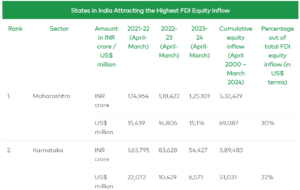
States must vie for FDI inflows: In his 78th Independence Day address to the nation, Prime Minister Narendra Modi emphasised the critical role of state governments in attracting foreign direct investment inflows. Highlighting that global companies are eager to invest in the country, he suggested that all states should engage in a state-level investment competition. He also urged state governments to establish clear policies that attract funding, offer assurances of good governance, and ensure confidence in the law and order situation to boost foreign investors’ confidence and promote green jobs.
By engaging in healthy competition to attract investors, states can provide local youth with new job opportunities. While the central government plays a pivotal role in attracting FDI, Modi noted that without a proactive approach by state governments, the country would struggle to secure significant inflows. To this end, policies must be refined and aligned with global standards.
READ I Retroactive mining tax order set to shake up industry
A few states manage to attract FDI inflows
In the financial year 2023-24, FDI inflows into India dropped to a five-year low, with total inflows amounting to $44.4 billion, slightly down from $46 billion in the previous fiscal year. This decline was largely due to global economic uncertainties and an increasing tendency for countries to focus inwardly when allocating capital.
Despite the overall decline, several Indian states — particularly Maharashtra, Gujarat, and Tamil Nadu — showed resilience and even growth in attracting FDI inflows. Gujarat and Tamil Nadu capitalised on their cluster-based industrial strategies, spanning a wide array of sectors, to sustain investment interest.



Gujarat emerged as the top performer in FY24, attracting $7.3 billion in fresh FDI equity inflows, according to data from the Department for Promotion of Industry and Internal Trade (DPIIT). This marked a remarkable 55% year-on-year growth. The surge allowed Gujarat to surpass both Karnataka and Delhi, securing the second-highest total FDI inflows for the fiscal year. The state’s success is largely attributed to significant high-profile investments, such as Micron’s new semiconductor plant.
Tamil Nadu and Maharashtra also saw growth in FDI flows, with year-on-year increases of 12% and 2%, respectively. While Tamil Nadu ranked sixth in total FDI inflows at $2.4 billion, it benefitted from significant investments in the electronics manufacturing sector, including the expansion of Foxconn and Pegatron’s facilities. Maharashtra’s steady performance underscores its long-standing reputation as a preferred destination for foreign investments in India.
However, Karnataka and Delhi, two states usually high on the list, reported declines. Karnataka, a startup hub, experienced a 37% year-on-year decline in FDI, continuing a downward trend that began in FY22. This drop is primarily due to a slowdown in startup funding and a perceived saturation in the state’s technology ecosystem. Similarly, Delhi saw a reduction in FDI inflows, decreasing by 13.4%, placing it fourth overall for FY24. In contrast, states like Bihar, Madhya Pradesh, Rajasthan, Jharkhand, and Uttar Pradesh showed poor performance, with high FDI volatility.
Cumulative FDI inflows into India from fiscal years 2000 to 2024 reveal Mauritius, Singapore, the USA, the Netherlands, and Japan as the top five contributors. In FY24, Singapore led the way, contributing $11.7 billion to the total FDI.
Boosting FDI inflows into states
FDI into states is generally influenced by the ease of doing business, government support in land acquisition, logistics, availability of infrastructure, and requisite manpower. As projects are usually established within states, more effort is required at their level to attract FDI. PM Modi suggested setting up a land bank in each state.
A land bank is a strategic tool used by governments to acquire, hold, manage, and develop land to promote public policy goals, such as economic development, affordable housing, or urban renewal. States or local governments may create land banks to assemble and prepare land for industrial parks, special economic zones, or other large-scale projects, making it easier and more attractive for investors to set up operations. However, analysts caution that the methodology for state-wise accounting of FDI is unclear and often depends on the headquarters location of the foreign enterprise.
Additionally, many analysts have flagged a trend where non-BJP-ruled states show a significant gap in FDI flows. Investors typically favour states with stable and consistent policy environments, where bureaucratic processes are streamlined, and business operations are facilitated.
To address this, the government must ensure that all states have developed infrastructure, particularly those that have lagged due to various factors. States should not suffer due to a lack of political alignment with the central government, as this can also influence FDI flows. Effective state leadership is crucial in driving development initiatives and enhancing investor confidence.
